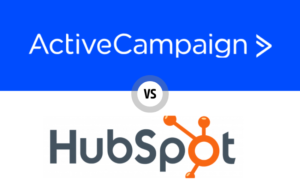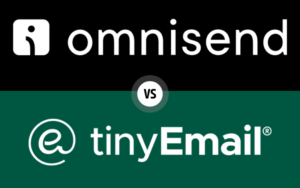Navigating the expansive world of email marketing tools brings us to a compelling face-off: MailPoet vs TinyEmail. In our dynamic digital era, having the right platform under your belt can be the difference between an average and an outstanding email marketing campaign. Both MailPoet and TinyEmail have garnered significant attention in this domain, each boasting a unique history and a set of features tailored to a variety of user needs.
With MailPoet’s deep integration into WordPress, it has become the darling of many bloggers and website owners, offering a seamless experience right from their website dashboards. In contrast, TinyEmail, though newer to the scene, impresses with its robust features catering to both novice marketers and industry veterans.
Which of these tools will lead your email marketing endeavors to success? Through this guide, we aim to unpack the specifics of MailPoet and TinyEmail, providing a clear picture of what each brings to the table. Join us in this exploration, as we delve into their individual strengths, capabilities, and areas for potential enhancement.
Table of Contents
Ease of Use and Interface
Navigating the complex world of email marketing tools, it’s crucial to prioritize platforms that offer both robust functionalities and an intuitive user experience. In this section, we pit MailPoet against TinyEmail, evaluating each on the basis of their interface and overall ease of use. Let’s dive deep into the MailPoet vs TinyEmail showdown in this domain.
MailPoet
MailPoet prides itself on offering a clean, user-friendly dashboard. Tailored primarily for WordPress users, MailPoet is embedded directly within the WordPress dashboard, making the integration seamless for those already accustomed to the platform. Even for novices, the drag-and-drop editor simplifies the process of crafting beautiful emails, while the straightforward navigation aids in effortless list management and campaign tracking.

TinyEmail
TinyEmail, on the other hand, appeals to a broader audience. It comes with a modern and minimalistic interface, designed to decrease the learning curve for users of all expertise levels. The main dashboard provides quick access to vital metrics and recent campaigns, ensuring users can get a snapshot of their efforts at a glance. Additionally, its editor, while versatile, maintains a simplicity that resonates with both beginners and seasoned marketers.

Comparison
When considering ease of use and interface in the MailPoet vs TinyEmail debate, both tools bring their unique strengths to the table. MailPoet’s deep integration with WordPress makes it an attractive choice for users of the popular CMS. In contrast, TinyEmail’s universally friendly design ensures that, irrespective of one’s technical prowess, the platform remains accessible and easy to grasp.
Both platforms emphasize user experience, but your personal preference and familiarity with WordPress might tilt the scales in favor of one over the other.
Email Design and Templates
In today’s digital age, the visual appeal of emails plays a significant role in grabbing your audience’s attention. Both the design flexibility and the availability of pre-designed templates can drastically influence a marketer’s choice. Let’s examine how MailPoet and TinyEmail fare in this crucial domain, making our way through the MailPoet vs TinyEmail comparison for email design and templates.
MailPoet
MailPoet offers a comprehensive suite of professionally designed templates that cater to a wide array of industries and purposes. Whether you’re announcing a new product, sending out a monthly newsletter, or sharing holiday greetings, there’s a template that fits the bill. The responsive designs ensure your emails look impeccable across devices. Additionally, the drag-and-drop editor allows for customization, ensuring each template can be tailored to resonate with your brand’s aesthetics.

TinyEmail
TinyEmail, keeping pace with industry demands, provides its users with a rich assortment of email templates. These templates are not only visually appealing but also optimized for high conversion rates. What sets TinyEmail apart is its focus on modular design, enabling users to mix and match different elements effortlessly. This approach empowers even those with no design background to craft visually stunning emails. Plus, with TinyEmail’s real-time preview feature, you can see how your design adapts to different devices and inboxes.

Comparison
The TinyEmail vs MailPoet debate in the realm of email design and templates is a tight one. Both platforms prioritize giving their users a variety of design options while ensuring ease of customization. MailPoet’s deep integration with WordPress might offer an added advantage for those looking to maintain consistent branding across their website and emails. However, TinyEmail’s modular approach and real-time preview ensure a level of flexibility and assurance that’s hard to beat.
In the end, the choice boils down to individual needs and preferences. Both platforms have their strengths, and marketers should consider their specific requirements when making a decision.
Automation Capabilities
Email marketing isn’t just about sending out beautiful emails. It’s about ensuring these emails reach your subscribers at the right time and under the right conditions. Automation capabilities can play a pivotal role in elevating the effectiveness and efficiency of an email campaign. Let’s delve deep into the MailPoet vs TinyEmail automation capabilities.
MailPoet
MailPoet is renowned for its seamless WordPress integration, making it a go-to choice for many WordPress site owners. This integration allows for easy automation triggers based on user actions on the website. For example, you can send out automated welcome emails, post notifications, and even WooCommerce follow-ups without a hitch. Their visual automation builder also simplifies the process of creating complex sequences, ensuring subscribers receive tailored content based on their interactions.
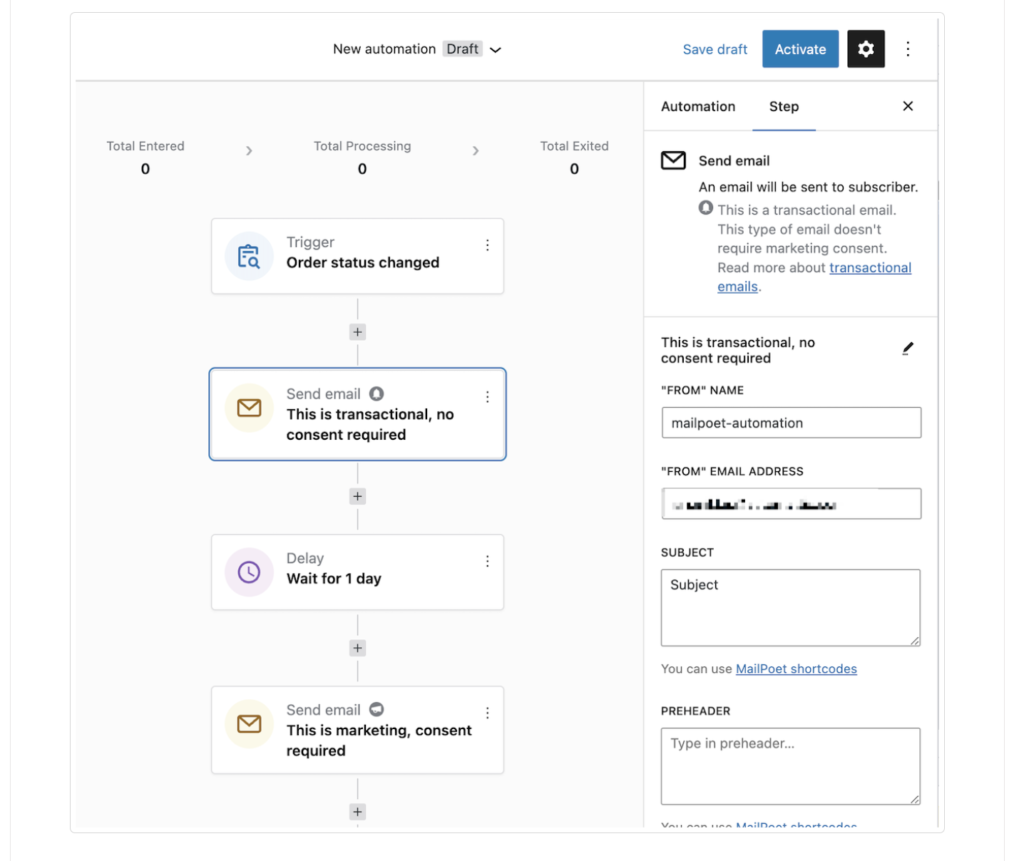
TinyEmail
When it comes to automation, TinyEmail offers an impressive array of functionalities. Beyond the standard welcome sequences and date-based automations, TinyEmail introduces behavior-based triggers. This allows marketers to craft campaigns that respond dynamically to subscribers’ actions, ensuring more personalized and timely interactions. Its intuitive automation workflow builder further simplifies the process, enabling marketers to visualize and design their email sequences with ease.

Comparison
Comparing MailPoet vs TinyEmail in terms of automation capabilities brings us to a crossroads. While MailPoet’s WordPress-centric automations are a boon for website owners looking for streamlined solutions, TinyEmail’s broader approach to behavior-based automation offers a more adaptable system for diverse marketing strategies.
Choosing between the two would require marketers to closely evaluate their automation needs. Those leaning towards deeper website integrations might find MailPoet more fitting, while others seeking dynamic and adaptable automations might lean towards TinyEmail.
Segmentation and Personalization
Segmentation and personalization are the cornerstones of effective email marketing. By segmenting your audience and sending tailored content, you can ensure higher engagement and conversion rates. Both MailPoet and TinyEmail understand the significance of these features, but how do they stack up against each other? Let’s dive into the MailPoet vs TinyEmail segmentation and personalization capabilities.
MailPoet
MailPoet’s deep integration with WordPress provides a unique advantage when it comes to segmentation. Users can easily segment subscribers based on their user roles, last purchase date, or even the specific pages they’ve visited. Additionally, MailPoet offers dynamic segments, ensuring lists are continually updated based on set criteria.
Furthermore, personalization in MailPoet is straightforward. With simple shortcodes, users can add personalized content like first names, ensuring each subscriber feels the message was crafted specifically for them.

TinyEmail
TinyEmail takes segmentation to another level by offering a plethora of conditions and combinations. Whether it’s segmenting subscribers based on the emails they’ve opened, the links they’ve clicked, or even custom fields, TinyEmail offers a granular approach. This flexibility ensures marketers can create extremely specific segments to target niche groups effectively.
On the personalization front, TinyEmail extends beyond just adding names. It allows users to include custom fields, thereby injecting tailored information or offers directly into the email content, catering to each subscriber’s specific interests or behaviors.

Comparison
When comparing TinyEmail vs MailPoet in terms of segmentation and personalization, it’s evident that both platforms offer robust tools. While MailPoet’s WordPress-centric features might appeal to website owners, TinyEmail’s in-depth segmentation and advanced personalization capabilities cater to those looking to get extremely specific with their targeting.
In conclusion, if you’re aiming for deep personalization and detailed segmentation based on diverse criteria, TinyEmail stands out. However, for WordPress users who want straightforward segmentation tied to their site’s data, MailPoet might be the preferable choice.
List Management and Import
The foundation of any successful email marketing campaign lies in the effective management of subscriber lists. A seamless process to import, manage, and maintain these lists can make a significant difference in a marketer’s workflow. In this section, we’ll compare the list management and import capabilities of MailPoet vs TinyEmail.
MailPoet
MailPoet offers a seamless experience when it comes to list management. Directly integrated with WordPress, it allows website owners to sync their user data effortlessly. Users can categorize subscribers based on their user roles, interactions, or even purchase history, providing a rich and dynamic list management system.
The import process in MailPoet is intuitive. With support for CSV and other popular file formats, users can quickly transfer their existing lists into the platform. Moreover, the system checks for duplicate entries and automatically cleans the list, ensuring optimal hygiene.
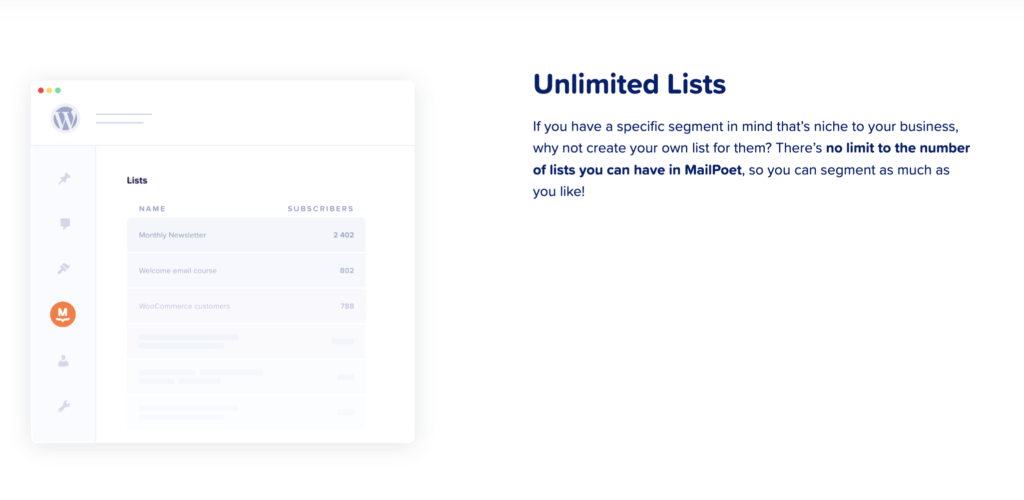
TinyEmail
TinyEmail excels in offering flexible list management options. Its user interface provides a clear view of all subscriber lists, along with detailed insights like engagement rates, bounce rates, and more. Filters and tags further enhance the list management experience, allowing marketers to segment and categorize subscribers with precision.
Importing lists into TinyEmail is a breeze. The platform supports a wide range of file formats and offers advanced mapping options. This ensures that every piece of data finds its correct place, even if the fields in the imported file don’t exactly match TinyEmail’s default fields.

Comparison
When evaluating MailPoet vs TinyEmail in the realm of list management and import, both platforms showcase strengths. MailPoet’s deep WordPress integration provides a unique advantage for website owners, ensuring lists are always up-to-date with the site’s user data. On the other hand, TinyEmail’s advanced list management features, combined with its flexible import options, cater to those looking for comprehensive control over their subscriber data.
In essence, for those deeply rooted in the WordPress ecosystem, MailPoet’s offerings may resonate more. However, for marketers seeking advanced list management tools and flexible import options, TinyEmail stands as a formidable choice.
Integration Capabilities
The ability to integrate seamlessly with other tools and platforms can elevate an email marketing tool’s functionality, ensuring it fits perfectly within an existing ecosystem of applications. Let’s dive into the integration capabilities of MailPoet vs TinyEmail to determine which offers a more holistic approach.
MailPoet
MailPoet, being natively integrated with WordPress, offers a seamless experience for website owners. This direct integration means that website data, from user sign-ups to e-commerce purchases, can be automatically synced with MailPoet lists.
Beyond WordPress, MailPoet provides connectors to a selection of popular tools. Whether it’s CRM systems, e-commerce platforms, or even third-party form builders, MailPoet ensures that data flow remains uninterrupted.
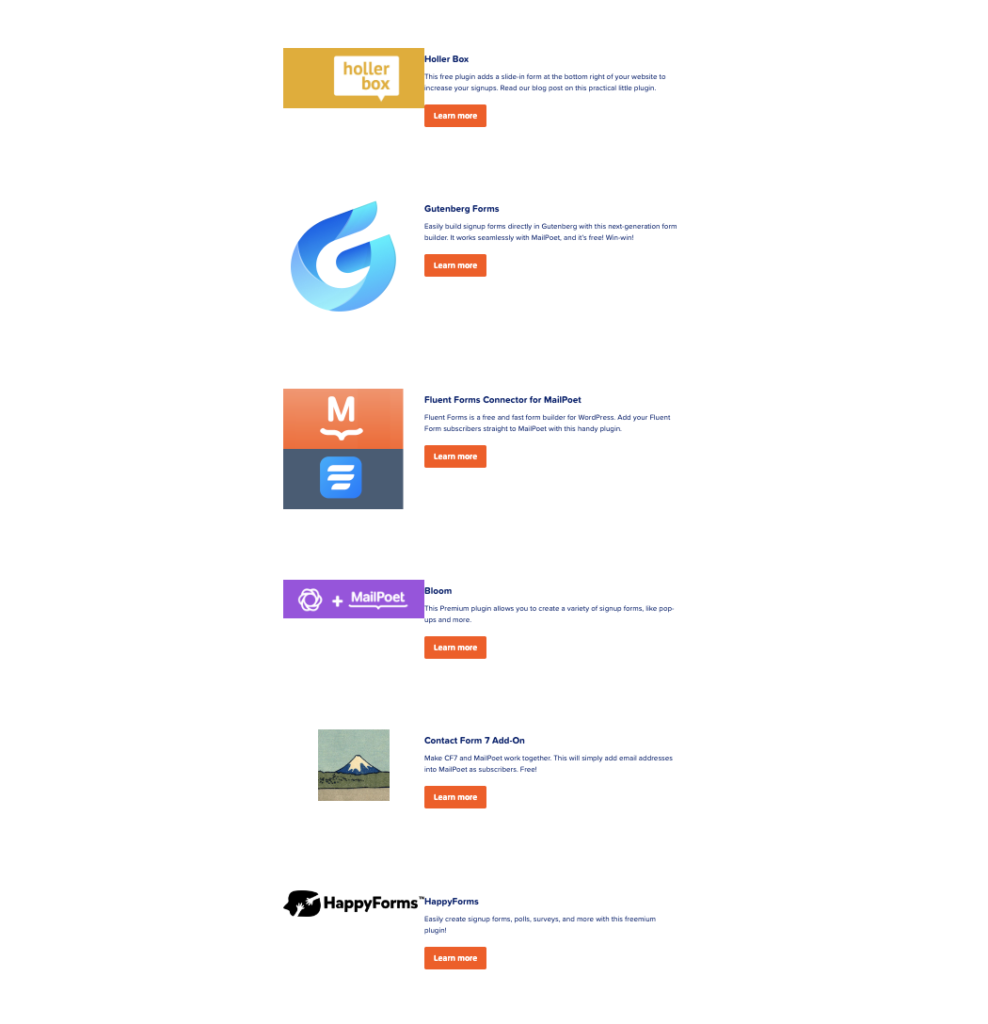
TinyEmail
TinyEmail has positioned itself as a versatile email marketing solution, and this is evident in its vast integration capabilities. With an extensive library of plugins and connectors, TinyEmail can link up with a diverse range of platforms — from CRM tools and payment gateways to webinar software and survey platforms.
What’s particularly impressive about TinyEmail is its open API, allowing businesses with custom solutions or unique platforms to build their integrations. This flexibility ensures that regardless of the tech stack a business is using, TinyEmail can find its place within it.

Comparison
Pitting MailPoet vs TinyEmail based on integration capabilities reveals distinct strengths for each platform. MailPoet’s deep WordPress integration makes it a top choice for businesses heavily reliant on the WordPress ecosystem. Its simplicity ensures that even users with limited technical expertise can make the most of it.
TinyEmail, on the other hand, shines with its extensive and flexible integration options. For businesses using a diverse set of tools or those who require custom integration, TinyEmail proves to be a robust choice.
Ultimately, the right platform will depend on the specific integration needs of the business. Both MailPoet and TinyEmail offer compelling advantages, and the decision should factor in the existing and potential tools a business plans to use.
Deliverability Rates
Deliverability rate is a critical metric in email marketing, representing the percentage of emails that successfully land in the recipient’s inbox without being flagged as spam or getting lost in the process. When comparing TinyEmail vs MailPoet, it’s essential to understand how each platform ensures optimal deliverability to maximize the impact of your campaigns.
MailPoet
MailPoet has heavily invested in its infrastructure to ensure that emails sent using its platform have a high deliverability rate. By partnering with renowned email sending services and maintaining adherence to industry best practices, MailPoet aims to ensure that your emails not only reach their destination but also escape the dreaded spam folder.
Another advantage of MailPoet, especially for WordPress users, is the direct integration, which provides better control over the sending process. This can lead to improved deliverability, especially when combined with regular list cleaning and engagement-driven content.
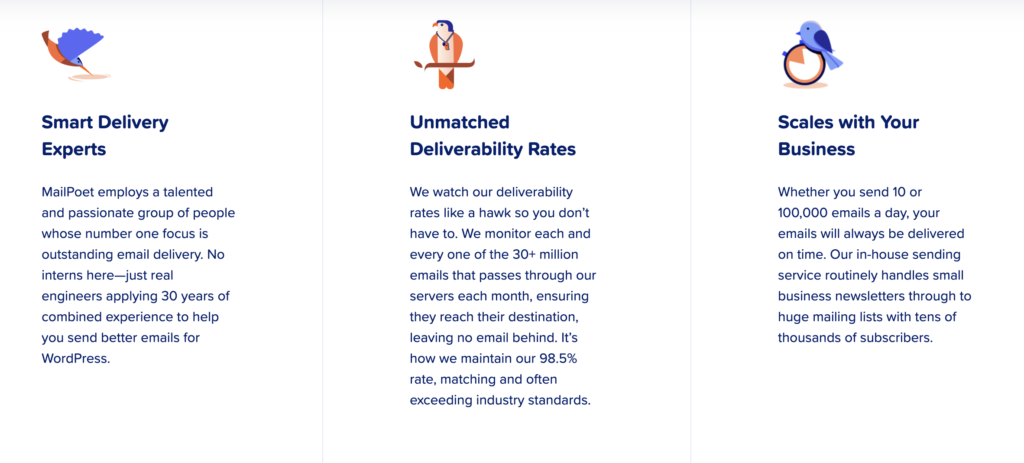
TinyEmail
TinyEmail takes a proactive approach to deliverability. The platform offers built-in tools that help users optimize their email content, subject lines, and sender reputation. By guiding users on best practices and offering feedback on potential red flags, TinyEmail ensures that the emails stand the best chance of reaching the recipient’s inbox.
Furthermore, TinyEmail maintains strong relationships with major email service providers and ISPs. This rapport ensures that any issues affecting deliverability are swiftly addressed, ensuring consistent and high inbox placement rates for users.

Comparison
In the battle of MailPoet vs TinyEmail regarding deliverability rates, both platforms demonstrate a commitment to achieving optimal results. MailPoet leverages its tight integration with WordPress and reliable email sending partnerships, while TinyEmail emphasizes proactive tools and strong relationships with email service providers.
For businesses, the choice might come down to their specific needs and preferences. Those who prioritize hands-on tools and guidance might lean towards TinyEmail, whereas businesses looking for a straightforward, integrated solution within the WordPress ecosystem might favor MailPoet.
Reporting and Analytics
Understanding your email campaigns’ performance is paramount to refining your strategy and achieving better results. Reporting and analytics tools allow marketers to extract insights, make data-driven decisions, and continually optimize their efforts. When it comes to the MailPoet vs TinyEmail showdown, let’s delve into how each platform caters to these analytical needs.
MailPoet
MailPoet offers an intuitive dashboard that provides users with a snapshot of their email campaign’s success. The platform tracks metrics like open rates, click-through rates, bounce rates, and more. Additionally, users can see which email content resonates most with their audience, thanks to the heatmap feature that highlights which sections of the email garnered the most engagement.
One notable benefit of MailPoet, especially for WordPress users, is its seamless integration with the website’s analytics. This allows for a more holistic view of how email campaigns drive website traffic, conversions, and other critical metrics.

TinyEmail
TinyEmail takes reporting to the next level with its comprehensive analytics suite. Users can dive deep into detailed reports that cover everything from subscriber growth and engagement patterns to geographical breakdowns of their audience. The platform even offers predictive analytics, using AI to forecast future campaign performance based on past data.
Moreover, TinyEmail provides tools for A/B testing, allowing users to split-test different email variations and gather insights on what works best for their audience. The platform also makes it easy to share these reports with team members or stakeholders, streamlining the decision-making process.

Comparison
When weighing MailPoet vs TinyEmail in terms of reporting and analytics, both platforms offer robust tools to understand and optimize email marketing efforts. While MailPoet shines with its straightforward dashboard and integration with WordPress analytics, TinyEmail goes a step further, providing advanced analytics, predictive insights, and A/B testing capabilities.
Ultimately, businesses should consider their analytical needs and how deep they wish to dive into their data. Those wanting a more comprehensive, data-driven approach might gravitate towards TinyEmail, while those looking for a simpler, integrated experience may find MailPoet more to their liking.
Customer Support and Resources
No matter how user-friendly or powerful an email marketing platform is, there will inevitably come a time when users need assistance. A platform’s customer support quality and the availability of resources can significantly impact a user’s overall experience. Here, we pit MailPoet against TinyEmail to see which platform truly shines in terms of support and resources.
MailPoet
MailPoet has carved a niche for itself with its detailed knowledge base, covering a wide array of topics from basic setup to more advanced troubleshooting. This self-help resource is designed for users to find solutions at their own pace, complete with step-by-step guides, video tutorials, and frequently asked questions.
For more pressing issues, MailPoet offers a dedicated support ticketing system where users can raise concerns or technical problems. Their support team is known for its timely responses and solution-oriented approach, ensuring minimal disruptions.

TinyEmail
TinyEmail, in its quest to offer a superior user experience, has developed a multi-faceted support system. Starting with an extensive library of articles and how-to guides, users are well-equipped to handle common challenges. Moreover, TinyEmail provides webinars and training sessions for those keen on mastering the platform’s nuances.
Beyond these resources, TinyEmail boasts a 24/7 live chat support feature. This ensures that users from different time zones can always find immediate assistance. The platform also offers email support and, for premium plan subscribers, a direct phone line for real-time problem resolution.
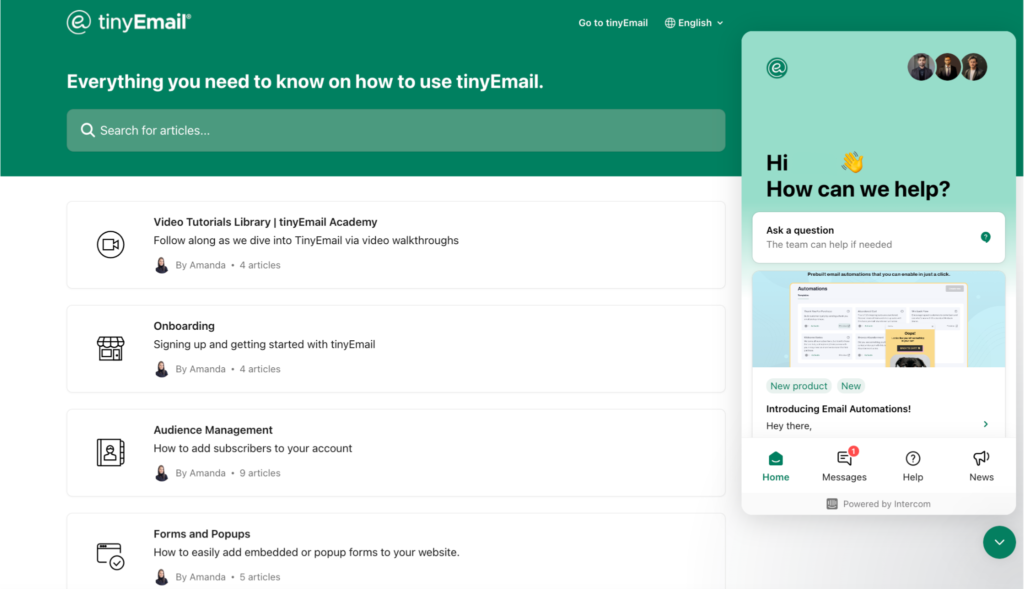
Comparison
Comparing MailPoet vs TinyEmail in the realm of customer support and resources, it’s clear that both platforms prioritize user experience. While MailPoet excels with its comprehensive knowledge base and responsive ticketing system, TinyEmail raises the bar with its round-the-clock live chat, exclusive webinars, and direct phone support for premium users.
Deciding between the two would boil down to individual preferences. Users valuing real-time, on-demand support might be swayed by TinyEmail’s offerings, whereas those content with self-help resources and traditional support methods might find MailPoet aligning better with their needs.
Pricing and Plans
When selecting an email marketing tool, the cost is undoubtedly a significant factor. The balance between features offered and the price point can greatly influence a user’s choice. In this section, we will dive deep into the pricing structures of MailPoet and TinyEmail to understand their value propositions.
MailPoet
MailPoet offers a tiered pricing structure to cater to different business needs. Their free plan is a magnet for beginners, offering basic features that can help startups or individual marketers kickstart their campaigns without financial burdens. As businesses scale and require more advanced tools, MailPoet’s premium plans come into play. These plans are structured based on the number of subscribers and offer a broader spectrum of features.

TinyEmail
TinyEmail’s pricing strategy is a blend of simplicity and flexibility. They too have a free plan for those just venturing into email marketing. Their premium plans are designed to offer more advanced functionalities, integrations, and automation capabilities. Like MailPoet, TinyEmail’s pricing increases with the number of subscribers. What sets them apart is their special enterprise package, tailored for large businesses with unique requirements.

Comparison
In the MailPoet vs TinyEmail pricing battle, both platforms present competitive structures aimed at different user segments. While both offer free plans, the real distinction lies in their premium offerings. MailPoet’s tiered approach provides scalability for growing businesses, ensuring they only pay for what they need. On the other hand, TinyEmail’s enterprise package showcases their commitment to catering to larger organizations with more intricate needs.
It’s worth noting that while pricing is crucial, the real value lies in the features and benefits each plan provides. Users must weigh the costs against the platform’s potential to meet their marketing goals effectively.
Security and Compliance
In today’s digital era, ensuring the security and compliance of the tools we utilize, especially those managing sensitive user data like email addresses, is paramount. Both MailPoet and TinyEmail recognize this importance, but how do they fare when pitted against each other in terms of security measures and compliance with data protection regulations? Let’s dissect their features to get a clearer picture.
MailPoet
MailPoet takes security seriously. With a dedicated security team in place, they continually work to safeguard their infrastructure and ensure that their user’s data remains protected. One standout feature is their rigorous encryption methods, ensuring that stored data remains inaccessible to unauthorized entities.
Furthermore, MailPoet is compliant with the General Data Protection Regulation (GDPR), assuring users within the European Union of stringent data protection standards. They also have transparent data handling and storage policies, further building trust with their users.

TinyEmail
TinyEmail places a significant emphasis on maintaining a fortified security architecture. Regular third-party security audits ensure that their systems remain impervious to breaches. Two-factor authentication is a commendable feature, adding an extra layer of security when accessing the platform.
Compliance-wise, TinyEmail doesn’t fall short. They are not only GDPR-compliant but also adhere to the California Consumer Privacy Act (CCPA), making them a reliable choice for users both in and out of the European Union. Their commitment to upholding these standards is evident in their regular compliance updates and transparency in their data processing activities.
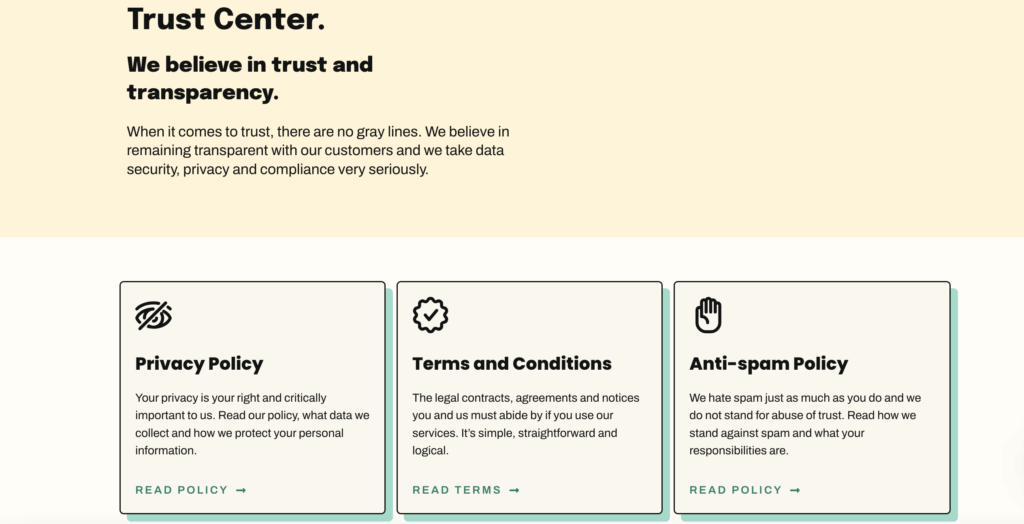
Comparison
When comparing MailPoet vs TinyEmail in terms of security and compliance, it’s evident that both platforms prioritize their users’ safety. While MailPoet focuses on strong encryption methods and GDPR compliance, TinyEmail extends its compliance reach to include CCPA and integrates features like two-factor authentication. The choice between the two will largely depend on individual preferences and the specific compliance needs of the user or business.
Mobile Optimization
The staggering rise in mobile device usage has made mobile optimization an absolute necessity for any digital tool, and email marketing platforms are no exception. With a significant portion of email opens occurring on mobile devices, it’s essential to ensure that emails look as intended, irrespective of screen size. So, how do MailPoet and TinyEmail measure up in this aspect? Let’s delve into the mobile optimization capabilities of MailPoet vs TinyEmail.
MailPoet
MailPoet recognizes the importance of mobile-friendly emails. Their platform offers responsive email templates, ensuring that emails auto-adjust to fit screens of all sizes. This ensures that campaigns retain their intended look and feel, whether viewed on a desktop, tablet, or smartphone.
Additionally, MailPoet’s user interface is designed to be mobile-responsive. This means that users can comfortably manage their campaigns and view analytics directly from their mobile devices without any hitches.

TinyEmail
TinyEmail is no slouch when it comes to mobile optimization. They provide an array of mobile-optimized templates, ensuring that emails remain visually appealing and functional across various devices. An added advantage is their mobile preview feature, allowing users to see exactly how their emails will render on mobile devices before hitting the send button.
Furthermore, TinyEmail offers a mobile application, making it easier for users to manage their campaigns, check analytics, and even draft emails on-the-go.

Comparison
In the realm of mobile optimization, both MailPoet and TinyEmail are proactive in ensuring that their users’ emails are displayed seamlessly across various devices. While MailPoet’s strength lies in its responsive templates and mobile-friendly interface, TinyEmail goes a step further with its dedicated mobile app and mobile preview feature. Deciding between MailPoet vs TinyEmail would hinge on whether a user prioritizes mobile interface management or a dedicated mobile app for on-the-go email marketing tasks.
Feedback and Reviews
Feedback and reviews offer a glimpse into real users’ experiences with a product, helping potential customers make informed decisions. For email marketing tools, user reviews can provide insights into the platform’s performance, ease of use, and overall value. Let’s assess the feedback and reviews for MailPoet vs TinyEmail to determine which platform users generally prefer and why.
MailPoet
MailPoet has made a considerable footprint in the email marketing space, and its user feedback reflects this. Most users commend MailPoet for its intuitive interface and seamless WordPress integration. Features like the drag-and-drop editor and automated newsletter capabilities have received favorable mentions. However, like any tool, MailPoet isn’t without its critics. Some users have pointed out occasional deliverability concerns and would appreciate more advanced segmentation features.

TinyEmail
TinyEmail’s user base has been vocal about their satisfaction with the platform’s robust automation tools and ease of use. The platform’s extensive template library and customization options have been particularly praised. User support and resources are also highlighted positively in most reviews. On the flip side, there have been occasional mentions about integration limitations with certain third-party tools and initial learning curves for some advanced features.
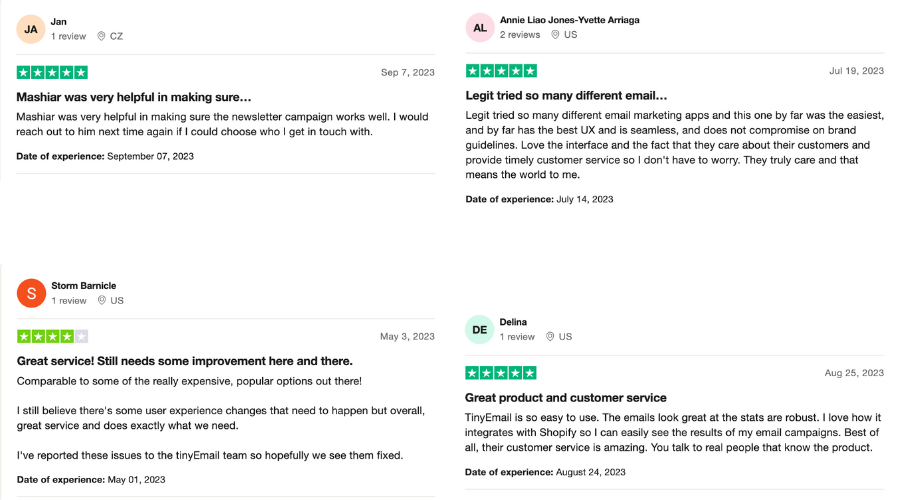
Comparison
Feedback and reviews offer a treasure trove of insights, and when it comes to MailPoet vs TinyEmail, the story is mixed. Both platforms enjoy a strong base of satisfied users, with each having its unique strengths. MailPoet’s seamless WordPress integration and TinyEmail’s automation prowess are particular highlights. However, potential users should weigh these strengths against the occasional concerns raised by some users.
To conclude, while feedback and reviews offer valuable insights, they’re just one piece of the puzzle. It’s essential to consider these reviews in conjunction with one’s specific needs and requirements when choosing between MailPoet vs TinyEmail.
Scalability
In the ever-evolving world of email marketing, the ability for a platform to scale with a business’s growth is paramount. As subscriber lists expand and campaign needs become more complex, the chosen email marketing tool must seamlessly grow alongside. In our comparison of MailPoet vs TinyEmail, scalability is a key consideration. Let’s dive into how each platform fares in this regard.
MailPoet
MailPoet, well-integrated with WordPress, is recognized for its ability to support budding bloggers and small businesses. As users’ mailing lists grow, MailPoet offers various pricing tiers that cater to different list sizes. Furthermore, its features are structured to assist users in managing larger lists and more intricate campaigns without a hitch. The integration capabilities with plugins and tools make it adaptable for growing needs. Nevertheless, larger enterprises with exceptionally vast email lists might occasionally find the platform’s upper limits constraining.

TinyEmail
TinyEmail’s framework is built with scalability at its core. The platform boasts robust automation tools and advanced segmentation capabilities which become increasingly crucial as businesses expand. TinyEmail’s cloud infrastructure ensures that as your list grows, the platform can handle increased loads with the same efficiency. Offering a range of plans, from starter to enterprise, TinyEmail ensures that businesses of every size find a tailored solution.

Comparison
When juxtaposing the scalability of MailPoet vs TinyEmail, it’s evident that both platforms are equipped to support businesses at various stages of growth. While MailPoet is a favorite among the WordPress community, especially for smaller to mid-sized ventures, TinyEmail stands out for its ability to cater to both small businesses and larger enterprises with equal efficiency.
To wrap up, the ideal choice between MailPoet vs TinyEmail in terms of scalability largely depends on individual business needs, projected growth, and platform preferences. Both offer commendable solutions, but it’s vital to align your choice with your long-term email marketing objectives.
Conclusion: MailPoet vs TinyEmail – The Final Verdict
Navigating the intricate waters of email marketing tools can be a daunting endeavor. However, understanding the nuances and strengths of each platform can significantly impact your marketing campaigns’ effectiveness. In our head-to-head comparison of MailPoet vs TinyEmail, we’ve delved deep into the features, pros, and potential setbacks of each tool, ensuring you have a clear roadmap to make an informed decision.
Both MailPoet and TinyEmail come with their unique sets of offerings. While MailPoet’s seamless integration with WordPress and its user-friendly interface might appeal to bloggers and small businesses, TinyEmail’s robust scalability and advanced automation tools make it a powerhouse for businesses poised for growth.
Yet, the ideal choice is not always black and white. It largely hinges on your specific needs, the scale of your operations, and your long-term marketing objectives. The most pertinent questions to ask are: What are your email marketing goals? Which platform’s features align best with those goals? And which tool offers the best value for your investment?
To sum it up, both MailPoet and TinyEmail stand tall in the vast landscape of email marketing tools. Your choice will ultimately boil down to the intricacies of your requirements and the vision you have for your brand’s email marketing future.
Thank you for joining us on this explorative journey comparing MailPoet vs TinyEmail. We hope this guide aids you in crafting a more informed, strategic, and impactful email marketing approach. Remember, the key to successful email marketing lies not just in the tool you choose, but in how effectively you wield its potential. Choose wisely, and here’s to your email marketing success!
Expand Your Knowledge with Our Previous Posts
Your exploration into the world of email marketing doesn’t have to stop with the MailPoet vs TinyEmail comparison. Dive deeper and gather more insights with these comprehensive guides:
- “ConvertKit vs TinyEmail: A Comprehensive Analysis”: Delve deeper into the functionalities and unique offerings of ConvertKit and TinyEmail.
- “GetResponse vs TinyEmail: A Thorough Comparison”: Navigate through an in-depth analysis of GetResponse and TinyEmail.
- “Moosend vs TinyEmail: Which Fits Your Needs?”: Whether it’s automation, integrations, or customer support, discover which platform aligns with your goals.
We strive to equip you with robust knowledge that emboldens your email marketing strategies. Keep revisiting our articles to stay updated and informed.



